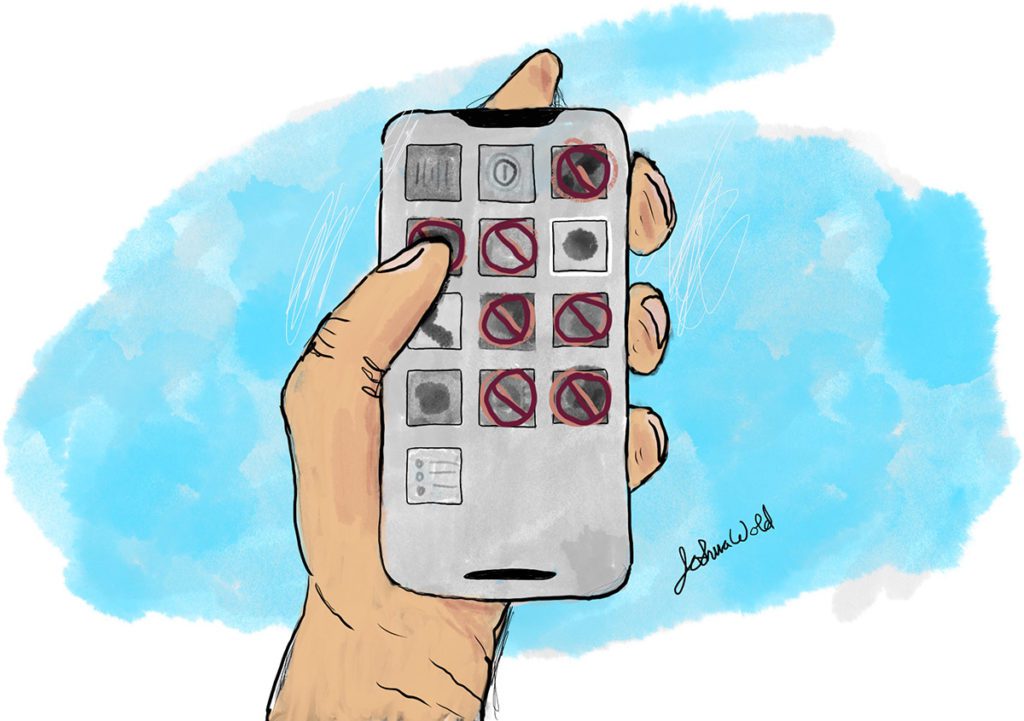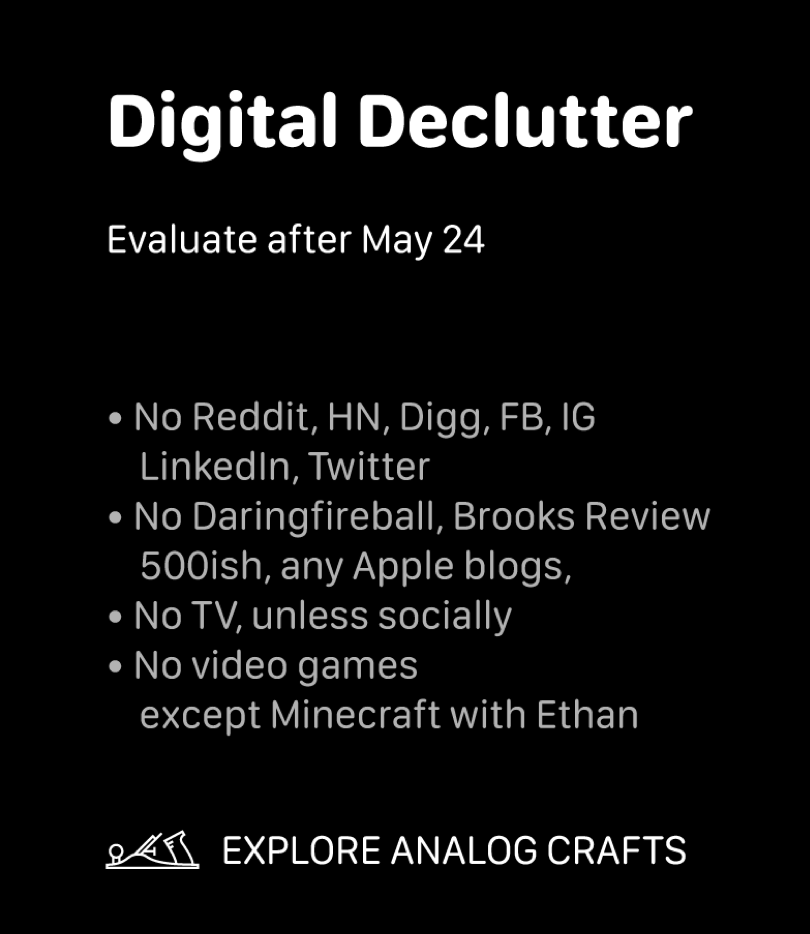
I’m too closely intwined with my digital life. I have a problem. At times it holds my attention more than my real life, and some days it’s hard to tell the two apart.
Technology has been wonderful for me. As a teenager, with unknown prospects for where I could take my life and career, technology opened doors for me. It’s been a force for good in my life, and because of that I’ve started to believe any new iteration of technology must be good.
As a young teenager I worked an entire Summer in the scorching heat of Arizona to save up enough money for my first laptop, costing roughly $1,500. Around that time I started to realize that computers weren’t just for gaming or instant messaging, I could also be creative. At that time a battle between my ability to create versus consume began. This was in 2001.
It all started with graphic design. I realized I could take my love of drawing into a digital medium and create things online. And, people would pay me for it.
Years later I added fancier devices: an iPhone and iPad, and had a full arsenal of software and hardware available to pursue creativity. But along the way the battle for creativity versus consumption picked up.
The first problem I faced was gaming. From ages 9-13 I was deeply absorbed in any game I could get my hand on. Entire months disappeared into fantasy worlds. Cracks in this cycle began when I realized I could be creative and earn some money with it.
For a few years things went in a more positive direction, I mostly ignored the consumption side of computer use, and technology became a tool primarily for career growth.
Then, slowly consumption crept back in. Digg, Reddit, Facebook, Instagram, LinkedIn, Gmail, Slack, all of my favorite tech and news sites, and more. Then, when I got my hands on an iPod Touch (and later an iPhone in 2012), the floodgates really opened up. Any information or entertainment I wanted was available to me, right at my the touch of a finger.
I successfully fought against most of it some of the time, especially since had personal and career interests that were more important. However, in all the spare moments between things, or when I felt that I was fighting too hard against learning something, the temptation to take a break and pull at the infinity pool in my phone became too strong.
Other than a few rare respites, my quiet times disappeared. At 31 years old, I’m right at the edge of a generation that remembers life before and after connected technology. I remember times of boredom and play away for screens.
I’ve tried a dozen ways to curb my internet and consumption use. I’ve tried life hacks, minimalism, and sheer force of will. Some days I win, and other days it’s too much to ignore the siren calls beckoning me.
With all of that context I tried something last month. I picked up a new book from Cal Newport called Digital Minimalism. I’m a huge fan of his work. His blog and previous books have inspired me in career decisions, as well as how I’ve used social media.
In 2016, inspired by Deep Work, I quit social media for 30 days. When I came back I realized how little I actually needed any of it. I have since eliminated my usage of social media by about 80%. My trick there has been to unsubscribe and unfollow everyone on all my accounts. It’s made social media mostly boring. However, I still go on to try and find a dopamine hit throughout the day. A decade of habits is hard to break, but I’ve gotten close.
When I saw a new book by Cal Newport, I knew I needed to read it, but hesitated for a few months. I was worried it would hit me over the head with guilt about the way I was too absorbed by consumptive technology. But I was wrong. It was a genuine and heartfelt guide to inspire all of us to live a better way. It offered encouragement and directions for how I could fight back against the tide.
In the middle of reading the book I decided it was time to spent 30 days disconnecting from the sources of mindless input I’ve grown accustomed to using. When I did this in 2016 I eliminated social media, now I wanted to include almost everything else.
At the same time. I was reading Make Time, a book by Jake Knapp and John Zeratsky. It describes a specific category of activities as infinity pools.
Infinity Pools are apps and other sources of endlessly replenishing content. If you can pull to refresh, it’s an Infinity Pool. If it streams, it’s an Infinity Pool. This always-available, always-new entertainment is your reward for the exhaustion of constant busyness.
This concept resonated with me. I have a lot of infinity pools. Even if the content they offer isn’t great, it’s still comforting to gaze in and try to get a dopamine hit. So, anything with a pull to refresh lever can count.
So, I knew I needed to try something. I also didn’t want to eliminate actual hardware devices, not yet at least. I wanted to see if there was another way.
For the past 11 years or so, I’ve willingly accepted most forms of technology into my life. Whether it’s entertainment, productivity, or learning, I’ve had a habit of trying it all. Now, because of my own attempts at simplifying my life, I’ve been able to successfully moderate a number of these sources of content.
However, I’m a single imperfect person fighting against consumption designed by some of the brightest minds in the world. Trying to hack my way through using these streams of data is a losing battle.
I may try to curb my social media use, cut down on news intake, and limit my time playing games and streaming TV. But it’s not enough. I can resist a few hours or days at a time, but I eventually go back.
So, when I heard about a plan from Cal Newport, I was inspired to try it.
The basic plan is to eliminate all consumption for 30 days. If it’s not critical to maintain relationships or your career, cut it out. There can be exceptions for specific cases, but on the whole this means no social media, no digital gaming, no tv or movies, and no content sites.
So, I wrote my list of things I’d eliminate for 30 days.
I then created a wallpaper and set it as a background on my phone and laptop. To further enforce the habit I blocked all of the domains on my devices.
Here’s the list:

So, how did it go?
For the first two days I felt jittery. I kept pulling out my iPhone to check Instagram, look at Reddit, or read one of my favorite blogs. I even typed the urls to my favorite sites multiple times without realizing what I was doing. It was only when I’d see a blocked site notice that I’d remember my detox plan.
After the first few days I settled into a few new routines. Because most of the sites I would normally visit were off limits, I used a lot of downtime for reading books, listening to podcasts, etc.
At night time, I went to bed roughly an hour earlier than I normally would, since reading a book isn’t nearly as stimulating as watching a movie or browsing Instagram.
In summary it was absolutely a good thing.
I’m now given it some thought for how I can make lasting changes.
As I’m writing this, I logged back into most of the sites I’d blocked, since we’re right on the 30 day mark.
On all of my social media accounts I only found two messages that were folks reaching out. I dropped a quick response back to both, but neither was urgent. On my favorite tech blogs I read through the last month of articles, and realized I hadn’t missed anything important.
Overall this detox was tremendously valuable for me. I still wasted some time on refreshing email and visiting sites that were useless (for example, box office results for Avengers: Endgame), but on the whole this detox gave me control of my time again.
The biggest takeaway is that I don’t need most of the sites I blocked, and I need to find better ways to use my time on the whole. We’ll see how that goes.